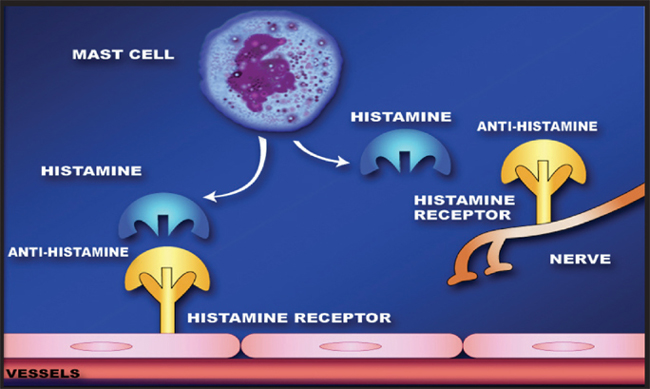The key difference between histamine and antihistamine is that the histamine is able to trigger allergic reactions while antihistamine is able to block the reaction of histamine and calm our body.
Our body synthesizes different chemicals such as neurotransmitters, hormones, enzymes, etc. Histamine and antihistamine are two important chemical messengers. They can be synthesized our body as well as can be introduced from the outside when needed. However, their functions are opposite. Histamine triggers allergic reaction while antihistamine reduces allergic reactions. Both these chemicals compete and bind with the same receptors. Hence, an antihistamine can block the binding of histamine to receptors and prevent its action.
CONTENTS
1. Overview and Key Difference
2. What is Histamine
3. What is Antihistamine
4. Similarities Between Histamine and Antihistamine
5. Side by Side Comparison – Histamine vs Antihistamine in Tabular Form
6. Summary
What is Histamine?
Histamine is an amine that incites allergic reactions when it encounters a benign compound inside the body. Our body produces histamines from the amino acid histidine. Histamine production occurs in the granules of mast cells and basophils. When the body needs an extra amount of histamine, it can be introduced from the outside sources as well.
Apart from triggering allergic reactions, histamine coordinates several other body functions too. Histamine can stimulate our immune system. It causes irritation, and it alerts white blood cells for the threat of foreign antigens. Furthermore, histamine stimulates smooth muscle contraction and gastric acid secretion. And also, it increases vascular permeability, cell proliferation, inflammation, immunomodulation, etc.

Figure 01: Histamine
In order to execute histamine function, it should bind to a receptor. There are four G protein-coupled histamine binding receptors. Namely, they are the H1, H2, H3, and H4 receptors. H1 and H2 receptors are located all over the body; especially, in the smooth muscle, endothelium and gastric mucosa. But, H3 is presynaptic, and H4 are haematopoietic. The H3 receptors mainly locate in the nerves in the gut while the H4 receptors mainly locate on the white blood cells.
What is Antihistamine?
Antihistamine is a medicine that treats allergy symptoms such as sneezing, watery eyes, hives, and a runny nose. Antihistamine competes with histamine for histamine receptors by acting as histamine antagonist, and thereby, blocks histamine reactions. Furthermore, antihistamine works by reducing the histamine-receptor activity on nerves, vascular smooth muscle, glandular cells, endothelium, and mast cells to prevent histamine actions. Also, antihistamines can be H1-antihistamines, H2-antihistamines, H3-antihistamines or H4 antihistamines. This classification tells us that what is the histamine receptor it blocks?. As an example, H1-antihistamines prevent the binding of histamine with H1 receptors.

Figure 02: Antihistamine
Furthermore, antihistamine medicines are available in the forms of capsules, tablets, liquids, eye drops, injections, and nasal sprays. These medicines can cause common side effects such as drowsiness, dry mouth, dizziness, headache, upset stomach, blurred vision, etc.
What are the Similarities Between Histamine and Antihistamine?
- Histamine and Antihistamine are chemical messengers.
- They compete for the same receptors.
- Also, the human body is able to synthesize both chemicals.
- Besides, they can also be introduced into our body from the outside.
- Both are necessary for the several functions in the body.
- Furthermore, both these chemicals actively involve with our sleep cycle.
What is the Difference Between Histamine and Antihistamine?
Histamine and antihistamine are two important compounds that mediate many functions in our body. Antihistamine does the opposite function of histamine. When histamine creates allergy reactions, antihistamine reduces the allergy reactions. This is the key difference between histamine and antihistamine. Another difference between histamine and antihistamine is that the histamine is responsible for wakefulness while the antihistamine is responsible for drowsiness. Histamine is also responsible for gastric acid secretion, smooth muscle contraction, irritation, etc. Both histamine and antihistamine compete for same types of receptors. This is the mechanism that antihistamine uses to block histamine action.

Summary – Histamine vs Antihistamine
Histamine is a chemical messenger or a neurotransmitter which cause allergy symptoms, irritation etc. Not limited to this, histamine also involves in many different physiological functions in our body. All these histamine reactions initiate when histamine binds with its receptors. There are four histamine receptors. When there is an allergy reaction, we tend to take medicines. These medicines are mainly antihistamines that work against histamines. Antihistamines prevent the binding of histamine with receptors or by reducing the activity of histamine-receptors. This is the difference between histamine and antihistamine.
Reference:
1.“Histamine and Antihistamines.” Anaesthesia & Intensive Care Medicine, Elsevier, 24 June 2011. Available here
2.“Antihistamine.” Wikipedia, Wikimedia Foundation, 24 Sept. 2018. Available here
Image Courtesy:
1.”Histamine” (Public Domain) via Commons Wikimedia
2.”Antihistamine”By Phn003 at English Wikibooks (Public Domain) via Commons Wikimedia
ncG1vNJzZmivp6x7pbXFn5yrnZ6YsqOx07CcnqZemLyue8OinZ%2Bdopq7pLGMm5ytr5Wau260yKyrmqWZo7Jurc2dZJqmpJ61qr%2FTmqSippVk